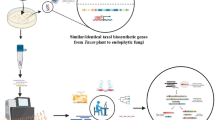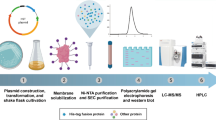Abstract
Highly iprodione- and fludioxonil-resistant field and laboratory isolates of A. brassicicola were found to be either moderately sensitive or tolerant to osmotic stress. AbNIK1, a two-component histidine kinase gene, was isolated from a fungicide-sensitive strain. The predicted protein possessed the six tandem amino acid repeats at the N-terminal end, which is a landmark of osmosensor histidine kinases from filamentous fungi. A comparison of the nucleic acid sequences of the AbNIK1 gene from fungicide-sensitive and fungicide-resistant isolates revealed the presence of mutations in six of the seven resistant strains analyzed. Null mutants were all found to be moderately sensitive to osmotic stress, indicating that they are similar to Neurospora crassa Type I os-1 mutants. Only one mutation, corresponding to a single amino acid change within the H-box of the kinase domain, was found in an osmotolerant strain. These results suggest that AbNIK1p participates in osmoregulation and that expression of the fully functional enzyme is essential for dicarboximide and phenylpyrrole antifungal activities.





Similar content being viewed by others
References
Adachi Y, Watanabe H, Tanabe K, Doke N, Nishimura S, Tsuge T (1993) Nuclear ribosomal DNA as a probe for genetic variability in the Japanese pear pathotype of Alternaria alternata. Appl Environ Microbiol 59:3197–3205
Alex LA, Borkovich KA, Simon MI (1996) Hyphal development in Neurospora crassa: involvment of a two-component histidine kinase. Proc Natl Acad Sci USA 93:3416–3421
Aravind L, Ponting CP (1999) The cytoplasmic helical linker domain of receptor histidine kinase and methyl-accepting proteins is common to many prokaryotic signalling proteins. FEMS Microbiol Lett 176:111–116
Catlett NL, Yoder OC, Turgeon BG (2003) Whole-genome analysis of two-component signal transduction genes in fungal pathogens. Eukaryot Cell 2:1151–1161
Corpet F (1988) Multiple sequence alignment with hierarchical clustering. Nucleic Acids Res 16:10881–10890
Cui W, Beever RE, Parkes SL, Weeds PL, Templeton MD (2002) An osmosensing histidine kinase mediates dicarboximide fungicide resistance in Botryotinia fuckeliana (Botrytis cinerea). Fungal Genet Biol 36:187–198
Cui W, Beever RE, Parkes SL, Templeton MD (2004) Evolution of an osmosensing histidine kinase in field strains of Botryotinia fuckeliana (Botrytis cinerea) in response to dicarboximide fungicide usage. Phytopathology 94:1129–1135
Dry IB, Yuan KH, Hutton DG (2004) Dicarboximide resistance in field isolates of Alternaria alternata is mediated by a mutation in a two-component histidine kinase gene. Fungal Genet Biol 41:102–108
Fujimura M, Ochiai N, Ichiishi A, Usami R, Horikoshi K, Yamaguchi I (2000) Fungicide resistance and osmotic stress sensitivity in os mutants of Neurospora crassa. Pestic Biochem Physiol 67:125–133
Fujimura M, Ochiai N, Oshima M, Motoyama T, Ichiishi A, Usami R, Horikoshi K, Yamaguchi I (2003) Putative homologs of SSK22 MAPKK kinase and PBS2 MAPK kinase of Saccharomyces cerevisiae encoded by os-4 and os-5 genes for osmotic sensitivity and fungicide resistance in Neurospora crassa. Biosci Biotechnol Biochem 67:186–191
Grindle M, Temple W (1982) Fungicide resistance of os mutants of Neurospora crassa. Neurospora Newsl 29:16–17
Guillemette T, Sellam A, Simoneau P (2004) Analysis of a nonribosomal peptide synthetase gene from Alternaria brassicae and flanking genomic sequences. Curr Genet 45:214–224
Iacomi-Vasilescu B, Avenot H, Bataillé-Simoneau N, Laurent E, Guénard M, Simoneau P (2004) In vitro fungicide sensitivity of Alternaria species pathogenic to crucifers and identification of Alternaria brassicicola field isolates highly resistant to both dicarboximides and phenylpyrroles. Crop Prot 23:481–488
Loomis W, Kuspa A, Shaulsky G (1998) Two-component signal transduction systems in eukaryotic microrganisms. Curr Opin Microbiol 1:643–648
Ma Z, Michailides TJ (2004) Characterization of iprodione-resistant Alternaria isolates from pistachio in California. Pest Biochem Physiol 80:75–84
Miller TK, Renault S, Selitrennikoff CP (2002) Molecular dissection of alleles of the osmotic-1 locus of Neurospora crassa. Fungal Genet Biol 35:147–155
Ochiai N, Fujimura M, Motoyama T, Ichiishi A, Usami R, Horikoshi K, Yamaguchi I (2001) Characterization of mutations in the two-component histidine-kinase gene that confer fludioxonil resistance and osmotic sensitivity in the os-1 mutants of Neurospora crassa. Pest Manag Sci 57:437–442
Oshima M, Fujimura M, Banno S, Hashimoto C, Motoyama T, Ichiishi A, Yamaguchi I (2002) A point mutation in the two-component histidine kinase BcOS-1 gene confers dicarboximide resistance in field isolates of Botrytis cinerea. Phytopathology 92:75–80
Pillonel C, Meyer T (1997) Effect of phenylpyrroles on glycerol accumulation and protein kinase activity of Neurospora crassa. Pestic Sci 49:229–236
Ruggiero T, Olivero M, Follenzi A, Naldini L, Calogero R, DiRenzo MF (2003) Deletion in a (T)8 microsatellite abrogates expression regulation by 3′-UTR. Nucleic Acids Res 31:6561–6569
Schumacher MM, Enderlin CS, Selitrennikoff CP (1997) The osmotic-1 locus of Neurospora crassa encodes a putative histidine kinase similar to osmosensors of bacteria and yeast. Curr Microbiol 34:340–347
Siebert PD, Chenchik A, Kellogg DE, Lukyanov KA, Lukyanov SA (1995) An improved PCR method for walking in uncloned genomic DNA. Nucleic Acids Res 23:1087–1088
Sutra L, Simoneau P, Gardan L (2001) Genetic diversity of Pseudomonas syringae pathovars and related species assessed by heteroduplex mobility assay. In: De Boer SH (ed) Plant pathogenic bacteria. Kluwer, Dordrecht, pp 128–130
Yoshimi A, Imanishi J, Gafur A, Tanaka C, Tsuda M (2003) Characterization and genetic analysis of laboratory mutants of Cochliobolus heterostrophus resistant to dicarboximide and phenylpyrrole fungicides. J Gen Plant Pathol 69:101–108
Yoshimi A, Tsuda M, Tanaka C (2004) Cloning and characterization of the histidine kinase gene Dic1 from Cochliobolus heterostrophus that confers dicarboximide resistance and osmotic adaptation. Mol Gen Genomics 271:228–236
Zhang Y, Lamm R, Pillonel C, Lam S, Xu JR (2002) Osmoregulation and fungicide resistance: the Neurospora crassa os-2 gene encodes a HOG1 mitogen-activated protein kinase homologue. Appl Environ Microbiol 68:532–538
Acknowledgements
This work was supported by the Contrat de Plan Etat-Région Pays de Loire (2000–2006). We wish to thank Angers Agglomération and the Gabonese government for providing H.A. with a doctoral fellowship. Thanks also to David Manley for critically reading the manuscript.
Author information
Authors and Affiliations
Corresponding author
Additional information
Communicated by U. Kück
Rights and permissions
About this article
Cite this article
Avenot, H., Simoneau, P., Iacomi-Vasilescu, B. et al. Characterization of mutations in the two-component histidine kinase gene AbNIK1 from Alternaria brassicicola that confer high dicarboximide and phenylpyrrole resistance. Curr Genet 47, 234–243 (2005). https://doi.org/10.1007/s00294-005-0568-2
Received:
Revised:
Accepted:
Published:
Issue Date:
DOI: https://doi.org/10.1007/s00294-005-0568-2




